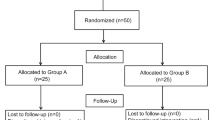Abstract
Purpose
In contrast to reports on the classical laryngeal mask airway (classical LMA; CLMA), no report has calculated the 50% and 95% effect-site concentrations (EC50 and EC95, respectively) of propofol required for flexible LMA (FLMA) insertion. This study was designed to determine the EC50 and EC95 of propofol for FLMA insertion, using probit analysis, and to investigate whether supplemental 0.25 μg·kg−1 fentanyl decreased these concentrations.
Methods
Fifty-nine unpremedicated patients who were scheduled for elective minor oral surgery were randomly allocated to a saline-propofol group (S-P group; n = 30) or a fentanyl-propofol group (F-P group; n = 29). Each group was further divided into four subgroups, in which the propofol EC for FLMA insertion was set at 2.5, 3.0, 3.5, and 4.0 μg·ml−1, respectively, in the S-P group and 1.8, 2.0, 2.5, and 3.0 μg·ml−1, respectively, in the F-P group,. The experiment was assessed as ”successful” when FLMA insertion within 1 min was possible.
Results
The EC50 and EC95 in the S-P group were 3.29 (95% confidence interval [CI], 2.83–3.93) and 4.73 (95% CI, 3.94–12.22) μg·ml−1, and those in the F-P group were 2.13 (95% CI, 1.42–2.60) and 3.54 95% CI, (2.78-34.78) μg·ml−1, respectively. The EC50 in the F-P group was significantly lower than that in the S-P group. There were no significant differences in bispectral index (BIS), hemodynamic variables, respiratory rate, and arterial oxygen saturation (\( Sp_{O_2 } \)) between the S-P and F-P groups.
Conclusion
The propofol EC50 for FLMA insertion was decreased by supplemental 0.25 μg·kg−1 fentanyl without BIS, hemodynamic, or respiratory depression.
Similar content being viewed by others
References
Brimacombe J, Keller C. Comparison of the flexible and standard laryngeal mask airways. Can J Anaesth. 1999;46:558–563.
Tsutsui F, Kodaka M. Propofol concentration requirement for laryngeal mask airway insertion was highest with the ProSeal, next highest with the Fastrach, and lowest with the Classic type, with target-controlled infusion. J Clin Anesth. 2005;17:344–347.
Casati A, Fanelli G, Casaletti E, Cedrati V, Veglia F, Torri G. The target plasma concentration of propofol required to place laryngeal mask versus cuffed oropharyngeal airway. Anesth Analg. 1999;88:917–920.
Kodaka M, Okamoto Y, Handa F, Kawasaki J, Miyao H. Relation between fentanyl dose and predicted EC50 of propofol for laryngeal mask insertion. Br J Anaesth. 2004;92:238–241.
Gourlay GK, Kowalski SR, Plummer JL, Cousin MJ, Armstrong PJ. Fentanyl blood concentration-analgesic response relationship in the treatment of postoperative pain. Anesth Analg. 1988;67:329–337.
Shafer SL, Varvel JR. Pharmacokinetics, pharmacodynamics, and rational opioid selection. Anesthesiology. 1991;74:53–63.
Barker P, Langton JA, Wilson IG, Smith G. Movements of the vocal cords on induction of anaesthesia with thiopentone or propofol. Br J Anaesth. 1992;69:23–25.
Brown GW, Patel N, Eliis FR. Comparison of propofol and thiopentone for laryngeal mask airway insertion. Anaesthesia. 1991;46:771–772.
Iannuzzi M, Iannuzzi E, Rossi F, Berrino L, Chiefari M. Relationship between bispectral index, electroencephalographic state entropy and effect-site EC50 for propofol at different clinical endpoints. Br J Anaesth. 2005;94:613–616.
Gepts E, Camu F, Cockshott ID, Douglas EJ. Disposition of propofol administered as constant rate intravenous infusion in humans. Anesth Analg. 1987;66:1256–1263.
Dixon WJ. Stairpatient bioassay: the up-and-down method. Neurosci Biobehav Rev. 1991;15:47–50.
Smith C, McEwan AI, Jhaveri R, Wilkinson M, Goodman D, Smith LR, Canada AT, Glass PS. The interaction of fentanyl on the Cp50 of propofol for loss of consciousness and skin incision. Anesthesiology. 1994;81:820–828.
Kazama T, Ikeda K, Morita K. The pharmacodynamic interaction between propofol and fentanyl with respect to the suppression of somatic or hemodynamic responses to skin incision, peritoneum incision, and abdominal wall retraction. Anesthesiology. 1998;89:894–906.
Kazama T, Ikeda K, Morita K, Katoh T, Kikura M. Propofol concentration required for endtracheal intubation with a laryngoscope or fiberscope and its interaction with fentanyl. Anesth Analg. 1998;86:872–879.
Kazama T, Ikeda K, Morita K. Reduction by fentanyl of Cp50 values of propofol and hemodynamic responses to various noxious stimuli. Anesthesiology. 1997;87:213–227.
Krasowski MD, Nishikawa K, Nikolaeva N, Lin A, Harrison NL. Methionine 286 in transmembrane domain 3 of the GABAA receptor β-subunit controls a binding cavity for propofol and other alkylphenol general anesthetics. Neuropharmacology. 2001;41:952–964.
Kamei J, Tanihara H, Kasuya Y. Antitussive effects of two specific κ-opioid agonists, U-50,488H and U-62,066E, in rats. Eur J Pharmacol. 1990;187:281–286.
Kamei J, Tanihara H, Kasuya Y. Modulation of μ-mediated antitussive activity in rats by a δ agonist. Eur J Pharmacol. 1991;203:153–156
Wang LP, McLoughlin P, Peach MJ, Kurowski I, Brandon EL. Low and moderate remifentanil infusion rates do not alter targetcontrolled infusion propofol concentrations necessary to maintain anaesthesia as assessed by bispectral index monitoring. Anesth Analg. 2007;104:325–331.
Tagaito Y, Isono S, Nishino T. Upper airway reflexes during a combination of propofol and fentanyl anaesthesia. Anesthesiology. 1998;88:1459–1466.
Manyam SC, Gupta DK, Johnson KB, White JL, Pace NL, Westenskow DR, Egan TD. Opioid-volatile anesthetic synergy. Anesthesiology. 2006;105:267–278.
Author information
Authors and Affiliations
About this article
Cite this article
Yumura, J., Koukita, Y., Fukuda, Ki. et al. Low dose of fentanyl reduces predicted effect-site concentration of propofol for flexible laryngeal mask airway insertion. J Anesth 23, 203–208 (2009). https://doi.org/10.1007/s00540-008-0728-x
Received:
Accepted:
Published:
Issue Date:
DOI: https://doi.org/10.1007/s00540-008-0728-x




